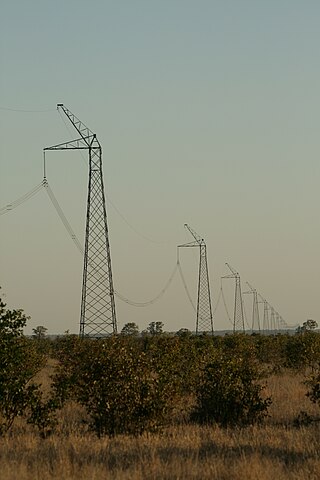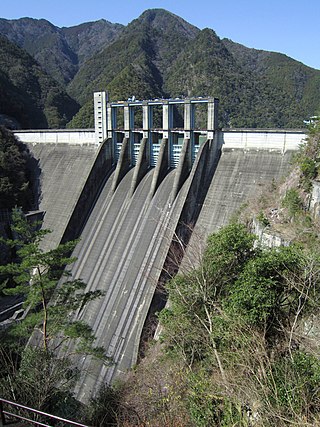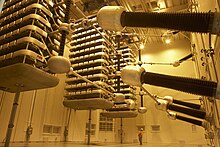
A high-voltage direct current (HVDC) electric power transmission system (DC) for electric power transmission, in contrast with the more common alternating current (AC) transmission systems.

A rectifier is an electrical device that converts alternating current (AC), which periodically reverses direction, to direct current (DC), which flows in only one direction. The reverse operation is performed by an inverter.

A power inverter, inverter, or invertor is a power electronic device or circuitry that changes direct current (DC) to alternating current (AC). The resulting AC frequency obtained depends on the particular device employed. Inverters do the opposite of rectifiers which were originally large electromechanical devices converting AC to DC.

The HVDC Volgograd–Donbass is a 475 kilometres (295 mi) long bipolar ±400 kV high voltage direct current powerline used for transmitting electric power from Volga Hydroelectric Station at Volgograd in Russia to Donbas in eastern Ukraine and vice versa.
The HVDC Inter-Island link is a 610 km (380 mi) long, 1200 MW high-voltage direct current (HVDC) transmission system connecting the electricity networks of the North Island and South Island of New Zealand together. It is commonly referred to as the Cook Strait cable in the media and in press releases, although the link is much longer than its Cook Strait section. The link is owned and operated by state-owned transmission company Transpower New Zealand.

The Pacific DC Intertie is an electric power transmission line that transmits electricity from the Pacific Northwest to the Los Angeles area using high voltage direct current (HVDC). The line capacity is 3.1 gigawatts, which is enough to serve two to three million Los Angeles households and represents almost half of the Los Angeles Department of Water and Power (LADWP) electrical system's peak capacity.

The Nelson River DC Transmission System, also known as the Manitoba Bipole, is an electric power transmission system of three high voltage, direct current lines in Manitoba, Canada, operated by Manitoba Hydro as part of the Nelson River Hydroelectric Project. It is now recorded on the list of IEEE Milestones in electrical engineering. Several records have been broken by successive phases of the project, including the largest mercury-arc valves, the highest DC transmission voltage and the first use of water-cooled thyristor valves in HVDC.
HVDC Kingsnorth was a high-voltage direct-current (HVDC) transmission system connecting Kingsnorth in Kent to two sites in London. It was at one time the only application of the technology of high voltage direct current transmission for the supply of transformer stations in a city, and the first HVDC link to be embedded within an AC system, rather than interconnecting two asynchronous systems. It was also the first HVDC scheme to be equipped with self-tuning harmonic filters and to be controlled with a "Phase Locked Oscillator", a principle which subsequently became standard on all HVDC systems.

Cahora-Bassa is an separate bipolar HVDC power transmission line between the Cahora Bassa Hydroelectric Generation Station at the Cahora Bassa Dam in Mozambique, and Johannesburg, South Africa.

An HVDC converter station is a specialised type of substation which forms the terminal equipment for a high-voltage direct current (HVDC) transmission line. It converts direct current to alternating current or the reverse. In addition to the converter, the station usually contains:

A mercury-arc valve or mercury-vapor rectifier or (UK) mercury-arc rectifier is a type of electrical rectifier used for converting high-voltage or high-current alternating current (AC) into direct current (DC). It is a type of cold cathode gas-filled tube, but is unusual in that the cathode, instead of being solid, is made from a pool of liquid mercury and is therefore self-restoring. As a result mercury-arc valves, when used as intended, are far more robust and durable and can carry much higher currents than most other types of gas discharge tube. Some examples have been in continuous service, rectifying 50-ampere currents, for decades.
The Eel River Converter Station is a high-voltage direct current (HVDC) converter station in Eel River Crossing, New Brunswick, Canada; it is the first operative HVDC station in the world equipped with thyristors.
The Sylmar Converter Station is the southern converter station of the Pacific DC Intertie, an electric power transmission line which transmits electricity from the Celilo Converter Station outside The Dalles, Oregon to Sylmar, a neighborhood in the northeastern San Fernando Valley region of Los Angeles, California. The station converts the 500 kV direct current coming from the northern converter station Celilo to alternating current at 60 Hz and 230 kV synchronized with the Los Angeles power grid. The station capacity is 3,100 megawatts. It is jointly owned by two electric utility providers, Southern California Edison and Los Angeles Department of Water and Power.

A static synchronous compensator (STATCOM), is a shunt-connected, reactive compensation device used on transmission networks. It uses power electronics to form a voltage-source converter that can act as either a source or sink of reactive AC power to an electricity network. It is a member of the FACTS family of devices.

GKK Etzenricht, an abbreviation of Gleichstromkurzkupplung Etzenricht, meaning Etzenricht HVDC-back-to-back station, was an HVDC back-to-back facility near Etzenricht in the district of Neustadt an der Waldnaab in Bavaria, Germany. It was built on the site of the Etzenricht substation, a 380 kV/220 kV/110 kV-substation, which went into service in 1970 and expanded afterwards several times. The facility was used between 1993 and 1995 for the exchange of power between Germany and the Czech Republic, operated by Bayernwerk AG.

The GK Dürnrohr was a high-voltage direct current back-to-back scheme west of Dürnrohr substation, which was used for the energy exchange between Austria and Czechoslovakia between 1983 and 1996. The installation is no longer in use.

The Sakuma Dam is a dam on the Tenryū River, located on the border of Toyone, Kitashitara District, Aichi Prefecture on the island of Honshū, Japan. It is one of the tallest dams in Japan and supports a 350 MW hydroelectric power station. Nearby a frequency converter station is installed, allowing interchange of power between Japan's 50 Hz and 60 Hz AC networks.
The Moscow–Kashira HVDC transmission system was an early high-voltage direct current (HVDC) connection between the town of Kashira and the city of Moscow in Russia, where the terminal was at 55°39′32″N37°38′16″E. The system was built using mercury-arc valves and other equipment removed from the Elbe Project in Berlin at the end of World War II. Although primarily experimental in nature, the system was the first true static, electronic, high-voltage DC scheme to enter service. Earlier DC transmission schemes had either used electromechanical converters based on the Thury system, such as the Lyon–Moutiers DC transmission scheme or had been at only medium voltage, such as the 12 kV frequency converter scheme at Mechanicville, New York in the United States.
An HVDC converter converts electric power from high voltage alternating current (AC) to high-voltage direct current (HVDC), or vice versa. HVDC is used as an alternative to AC for transmitting electrical energy over long distances or between AC power systems of different frequencies. HVDC converters capable of converting up to two gigawatts (GW) and with voltage ratings of up to 900 kilovolts (kV) have been built, and even higher ratings are technically feasible. A complete converter station may contain several such converters in series and/or parallel to achieve total system DC voltage ratings of up to 1,100 kV.
The Xiangjiaba–Shanghai HVDC system is a ±800 kV, 6400 MW high-voltage direct current transmission system in China. The system was built to export hydro power from Xiangjiaba Dam in Sichuan province, to the major city of Shanghai. Built and owned by State Grid Corporation of China (SGCC), the system became the world’s largest-capacity HVDC system when it was completed in July 2010, although it has already been overtaken by the 7200 MW Jinping–Sunan HVDC scheme which was put into operation in December 2012. It also narrowly missed becoming the world’s first 800 kV HVDC line, with the first pole of the Yunnan–Guangdong project having been put into service 6 months earlier. It was also the world’s longest HVDC line when completed, although that record is also expected to be overtaken early in 2013 with the completion of the first bipole of the Rio Madeira project in Brazil.











